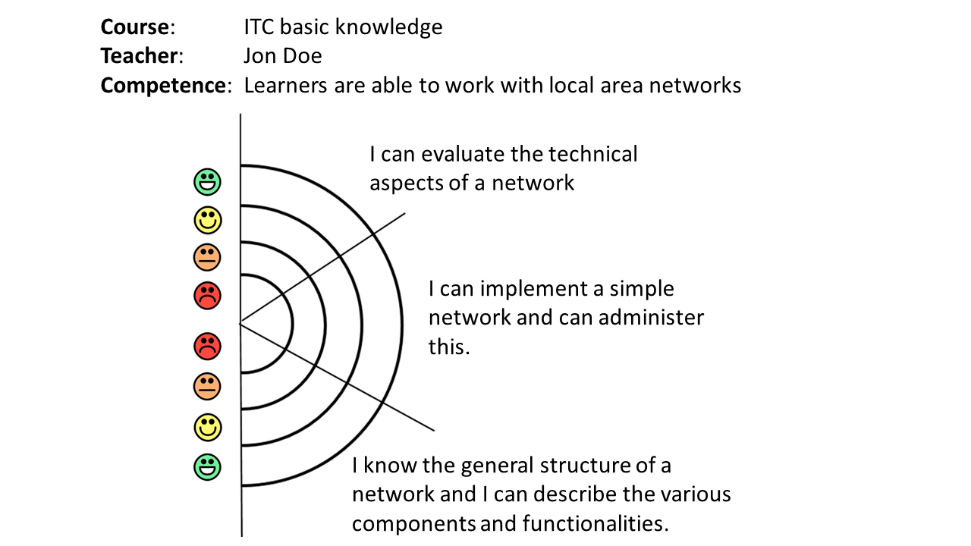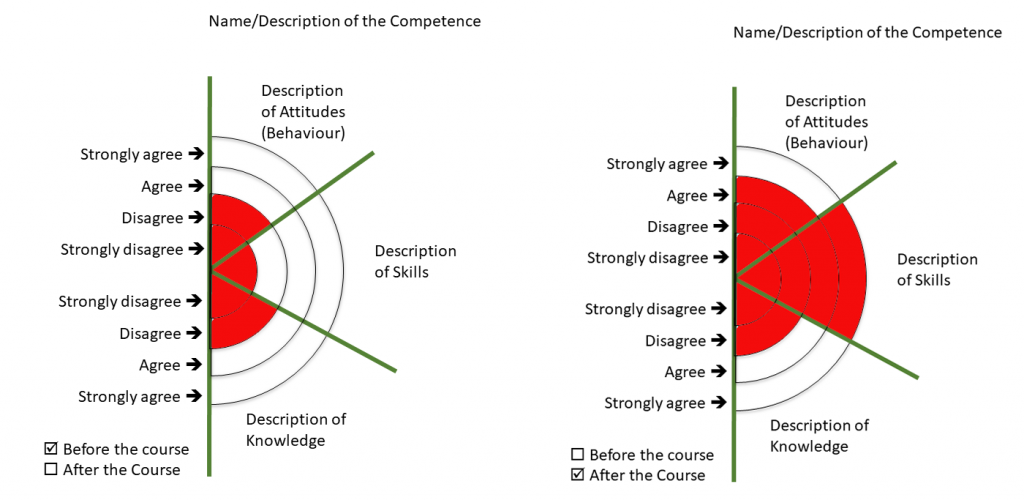The development of the mandala – from the idea to the tool
To express the competencies a depiction based on a half-circle was developed and labeled with the three competence items: knowledge, skills, and attitudes. The heading defines the description of the competence.

Figure 1: Basic considerations of the depiction (source: Peter Mazohl)
Use of a Likert-scale
To offer the possibility to express the self-estimation in the three fields each field is split into four areas. This follows the idea of a Likert-based scale. These areas represent the various levels (worst level near the middle point of the half-circle, the best value in the area with the biggest distance of the middle point).

Figure 2: The mandala with four different levels for each part of the competence (source: Peter Mazohl)
In contrast to the classical levels of Likert-based scale (which uses five levels), the neutral mid-level was dropped. With four levels, each learner must decide on a valuable level from the beginning and cannot decide on the non-committal neutral middle value. To comply with the educational field emoticons have been selected to express the level of agreement.
How to use the Mandala
Before the course, the learners color their estimated levels of each item of competence. This can be done with several different methods:
- Printing the mandala, painting the selected areas with a pencil, taking an image with a smartphone, and finally uploading the image to the learning platform.
- Provision of the mandala in an electronic format (for example an image in JPeG or PNG format) and the learners use an image editor to paint the selected areas. This needs digital competencies (to download, save, edit with an image processing or editing program, to save the mandala again, and finally to upload it to the learning platform).
After the course, the empty mandala is taken again and colored by the learners. The difference between the two mandalas makes the learning success directly visible.

Figure 3: The painted mandala. Left: before the course; right: after the course. (source: Peter Mazohl)
This mandala has been taken from a proposal to implement the mandalas in Adult Education by replacing the emoticons by text.
The tool
Here you will find the Mandala creation tool (creating Self-Evaluation Mandalas online or offline using Word or Libre Office)
Further readings
The Self-Evaluation Mandala is an innovative tool and has been developed in 2016 by Peter Mazohl. The tool has been evaluated in an international context within the VTT-Box project. Therefore, there are not so many sources available currently.
- Mazohl, Peter; Makl, Harald (2018): SELF-EVALUATION MANDALAS – AN INNOVATIVE TOOL OF THE VIRTUAL TEACHERS’ TOOLBOX VTT PROJECT. In Luis Gómez Chova, Agustín López Martínez, Ignacio Candel Torres (Eds.): ICERI2018 Proceedings. 11th annual International Conference of Education, Research and Innovation. Seville, Spain, 11/12/2018 – 11/14/2018: IATED (ICERI Proceedings), pp. 180–186.
________________
Source: This text was written by Peter Mazohl and published at the EDEN annual conference 2019 (in Brugges): Connecting through Educational Technology Proceedings of the European Distance and E-Learning Network 2019 Annual Conference Bruges, 16-19 June 2019 ISBN 978-615-5511-27-1, p 213
Creative Commons License CC BY-NC-SA
![]()